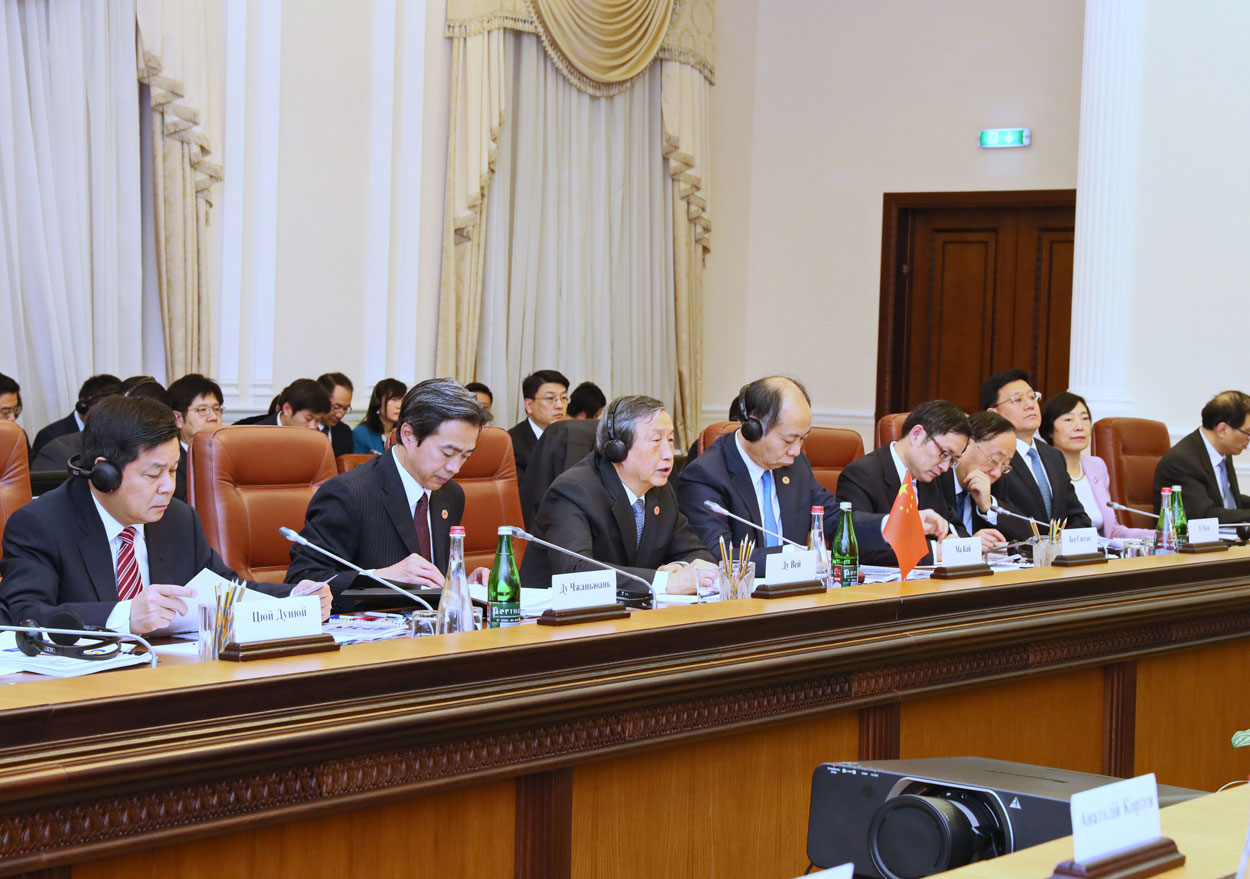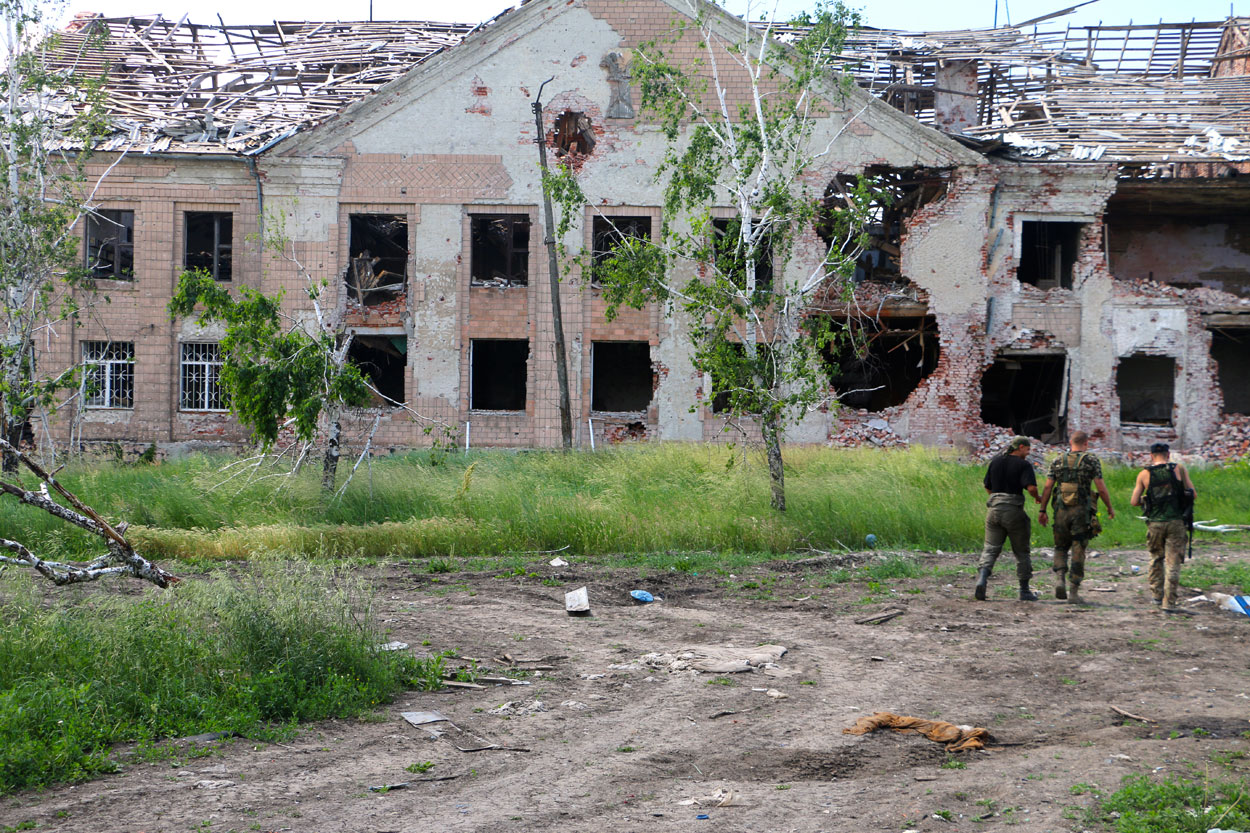KYIV, Ukraine—A top Chinese official visited Kyiv this week to announce a host of new infrastructure projects and investments in Ukraine, underscoring a burgeoning economic relationship between the two countries that could nudge Kyiv away from the West—a scenario that would ultimately benefit Moscow, some say.
“Russian-Chinese relations have no reason to diverge over Ukraine, particularly in the short term,” Franklin Holcomb, a Russia and Ukraine analyst at the Institute for the Study of War, told The Daily Signal.
“An acceptable end state for both countries would likely be a Ukraine that is under Russian political and military influence, is being rebuilt with Chinese funds, and serves as a conduit for Chinese influence to Europe, where Western influence is minimized,” Holcomb said.
Ukraine is at the nexus of a spider’s web of geopolitical interests, including those of Russia, the United States, the European Union—and now China.

Chinese Vice Premier Ma Kai (third from the left) addresses the third session of the China-Ukraine Intergovernmental Commission in Kyiv, Ukraine, Dec. 5, 2017. (Photo: Xinhua/Sipa USA/Newscom)
For its part, Beijing has ramped up its investments in Ukraine to prepare Ukraine’s transportation infrastructure for its role as a portal into Europe for China’s proposed One Belt, One Road overland trade route across Asia.
“China has been and still remains our strategic partner and our strategic priority,” Ukrainian Prime Minister Volodymyr Groysman said Tuesday after a meeting with Chinese Vice Premier Ma Kai, who was in Kyiv for talks.
Following Tuesday’s meeting in Kyiv, Kai told reporters, “We consider Ukraine as one of the logistics and industrial hubs on the way to the European Union.”
Also known as the “New Silk Road,” the One Belt, One Road initiative is Chinese President Xi Jinping’s foreign policy mantelpiece. Accordingly, Beijing wants Ukraine to become a stable, reliable partner through which Chinese goods can flow into Europe.
To that end, during his visit to Kyiv, Kai announced plans for $7 billion in joint projects between China and Ukraine. In turn, Groysman announced that 2019 would be the “year of China” in Ukraine.
Synergy
Meanwhile, Ukraine and Russia have been in a de facto state of war for almost four years, dating back to Russia’s March 2014 invasion and seizure of Crimea.
A Russian-sponsored proxy war continues to simmer in eastern Ukraine. The February 2015 cease-fire, known as Minsk II, has failed. The war is now a low-intensity, static, trench warfare conflict in which, on average, one Ukrainian soldier dies every three days. So far, the war has killed more than 10,200 Ukrainians.
Moscow wants to weaken Ukraine economically and politically to forestall its Western pivot—particularly any aspirations of Ukraine one day joining the EU or NATO.
At first take, Russia and China appear to have conflicting interests in Ukraine. Yet, many experts say that’s not necessarily the case.
“China at odds with Russia in Ukraine? Not at all,” Fatima-Zohra Er-Rafia, a corporate consultant and researcher who specializes in Asia, told The Daily Signal.
“On the contrary, China is not competing with Russia over Ukraine,” Er-Rafia said. “They are working in synergy in Ukraine.”
One line of thinking is that China would ultimately prefer Ukraine to be in Russia’s orbit rather than the West’s. And the level of instability in Ukraine due to Russian aggression is not likely to rattle Chinese investors, who are well acquainted with doing business in risky markets.
“There are differences between Russia and China but their interests are not mutually exclusive,” said Steven Tsang, associate fellow at Chatham House and director of the China Institute at SOAS University of London.
“Beijing is supportive of Russia’s efforts to strain Ukraine’s relations with the West, though it also prefers Ukraine not to be so destabilized that it becomes bad for Chinese business,” Tsang told The Daily Signal. “The existing level of pressure Russia is putting on Ukraine is not sufficient to get the Chinese government deeply concerned.”
Plan B
Russian influence in Ukraine evaporated after the 2014 Maidan revolution overthrew Ukraine’s then-President Viktor Yanukovych—a Kremlin ally who dutifully fled to exile in Russia after his ouster.
Russia’s subsequent hybrid war gambit to obstruct Ukraine’s turn to the West has backfired.
Anti-Russian sentiments have skyrocketed within Ukrainian society and its politics. Rolls of toilet paper adorned with the likeness of Russian President Vladimir Putin have been a staple among street merchants in Kyiv since 2014.
One telling signal of the Russo-Ukrainian split has been the renaissance of Ukraine’s military, which was a broken force prior to 2014.
To counter Russia, Ukraine has since rebuilt its armed forces into Europe’s second-biggest in terms of active-duty ranks (second only to Russia’s), singling out Russia as the “aggressor nation” in the process. The end goal of Ukraine’s military rebuild is to meet NATO interoperability standards by the year 2020.
On the economic front, Ukraine has undergone a purge of all things Russian since the 2014 revolution.
Although, the Kyiv Post reported in March that Russia remains Ukraine’s top export destination and biggest foreign investor.
Of note, Ukraine has completely weaned itself off of Russian natural gas, as well as Russian-made parts for its military equipment—no small feats for the post-Soviet country.
Moscow may not be able to re-establish its direct influence over Ukraine in the current political climate. So, from the Russian perspective, a Ukraine economically beholden to China might be the next best option to forestall Ukraine’s pro-Western transformation.
“Russia’s strategic goal is to pull Ukraine as a whole from European influence,” Er-Rafia said. “To achieve this goal, Russia encourages China to invest in Ukraine … China is helping Russia to keep Ukraine in its zone of influence.”
Made in China
The post-revolution economic divorce between Russia and Ukraine has left Ukraine looking for new markets in which to sell its goods, as well as new foreign investors to jump-start its economy.
In both respects, China has proven to be a lucrative alternative to Russia. Although, swapping China for Russia may not be the economic emancipation Ukraine is looking for.
“A politically stable, Westward-leaning Ukraine would not be in China’s interests … a Ukraine firmly in Russia’s orbit might be preferable,” Dean Cheng, senior research fellow for The Heritage Foundation’s Asian Studies Center, told The Daily Signal.
Over the first nine months of 2017, trade between Ukraine and China increased by 14.5 percent—reaching about $5.6 billion.
Ukrainian agriculture exports have contributed to the boost in trade. Ukraine has taken over from the U.S. as China’s top supplier of corn. Five years ago, the U.S. supplied about 97 percent of corn imported by China. Today, roughly 95 percent of it comes from Ukraine.
China is now the top purchaser of military equipment from Ukraine, totaling $90 million in sales in 2016.
China has already had a hand in rebuilding Ukraine’s transportation infrastructure, underscoring the importance of Ukraine to the One Belt, One Road initiative. Kyiv has awarded multiple contracts worth tens of millions of euros for Chinese companies to upgrade Ukrainian highways.
Beyond roadwork, Beijing has plans for a $400 million passenger railway connecting Kyiv Boryspil International Airport and Kyiv. And a Chinese company has been dredging Ukraine’s Yuzhny port, the country’s busiest.
China is also investing in other sectors of Ukraine’s economy. Ivan Miroshnichenko, a Ukrainian member of parliament, told Ukrainian media that China could invest $8 to $12 billion in Ukraine over the next five years.
Last week, Chinese officials expressed interest in purchasing aircraft from Ukraine’s Antonov aircraft manufacturing company, as well as licensing Chinese companies to produce spare parts for any aircraft China buys. (Antonov recently cut itself off from all Russian part suppliers.)
And in November, China’s Bohai Commodity Exchange acquired the Ukrainian Bank for Reconstruction and Development, or UBRD. At a press conference in Kyiv on Thursday, Bohai CEO Yang Dong Sheng said the UBRD should become “a platform for organizing cooperation in the investment sphere between Ukraine and China.”
Lingering corruption and Russia’s war in the east have dampened Western investment in Ukraine. China, on the other hand, is unfazed so far.
“I don’t get the sense the Chinese are about to start pressuring anyone to back off their wars,” Cheng, The Heritage Foundation fellow, said. “This might change once [One Belt, One Road] takes off, but we’re not there yet.”
No Strings Attached
Kai’s visit to Kyiv came as both the EU and the U.S. unleashed criticism on Ukraine’s government for its faltering anti-corruption reforms.
On Dec. 1, the European Union announced it was withholding the final 600 million-euro tranche of a larger 1.8 billion-euro financial assistance package to Ukraine. Kyiv’s failure to fulfill reform requirements spurred the move, the EU said.
The U.S. also recently knocked Ukraine’s reform efforts. On Dec. 4, the State Department issued a blunt statement urging Ukrainian lawmakers to pick up the pace of anti-corruption efforts.
“It serves no purpose for Ukraine to fight for its body in Donbas if it loses its soul to corruption,” U.S. Secretary of State Rex Tillerson said in the statement, which was posted to the State Department’s website, referring to Russia’s ongoing proxy war in Ukraine’s eastern Donbas region.
With both the EU and the U.S. apparently losing patience with Kyiv, China could have an opening to quietly gain leverage through economic inducements that are not tied to any to-do list of reforms. An outcome Moscow would surely welcome.
“While Russia might prefer that nobody invest in Ukraine in order to increase economic pressure on Kyiv, it lacks the tools to achieve this goal,” said Holcomb, the Institute for the Study of War analyst. “In this context, China’s ruthlessly pragmatic investment is preferable to similar Western initiatives which come tied with democratic values, which Moscow perceives as a strategic threat.”
Same Page
Russia and China are in the midst of a diplomatic rapprochement, founded, in principle, on a common aversion to the U.S.-led, post-war world order.
“The Chinese, and especially Xi Jinping, see the collapse of the USSR as a catastrophe,” Cheng said. “It left the U.S. in charge, but it also implied that states could disintegrate. The parallel for the [People’s Republic of China] is obvious … So, a Ukraine that was reabsorbed into Russia might not be so bad.”
Putin and Xi outlined their common worldview in a July joint statement.
“Both sides believe that the current international system is moving towards multi-polarization,” the joint Russian-Chinese statement read.

Battle scars in eastern Ukraine evidence a war that has not yet ended. (Photo: Nolan Peterson/The Daily Signal)
The two countries, therefore, are inclined to see eye to eye in areas of overlapping interests, such as their respective goals in Ukraine, for the sake of maintaining good relations in pursuit of a common cause.
“China and Russia have different objectives in Ukraine, but neither side will allow those differences to derail the development of Sino-Russian relations,” Ryan Hass, a fellow at the Brookings Institution, told The Daily Signal. “I do not expect that pattern to change, even with China’s ongoing efforts to boost relations with Ukraine.”
China may want to set a historical precedent in Ukraine by nudging the country back into Russia’s orbit, as Cheng suggested. Although, Beijing may not ultimately see Ukraine’s fate as an either-or choice between Russia and the West, as Moscow does.
“I think Beijing looks at this from a different prism,” Tsang, the Chatham House fellow, said. “It does not want Ukraine back in Russia’s orbit, but it does not want to see Ukraine in Western Europe’s orbit either. It prefers Ukraine put a higher priority in developing its relationship with China.”
Power Broker
Kai’s visit to Kyiv this week underscored a broader Chinese effort to increase its sway over Central and Eastern Europe. A gambit, some say, that should raise U.S. officials’ eyebrows, especially in light of Russia’s continuing hybrid aggression in that same region.
“Yes, America should be concerned about increasing Chinese economic influence in Ukraine and across Eastern Europe,” Holcomb said. “If Chinese investment and Russian aggression in Eastern Europe are not matched by corresponding U.S. economic and military measures in coming years, the U.S. and its partners risk ceding influence in the region to hostile revanchist powers.”
China has positioned itself as a regional power broker in Central and Eastern Europe. Across the region, China has been laying the groundwork for its One Belt, One Road Initiative through a laundry list of various agreements and initiatives.
In 2012, Beijing spearheaded the “16+1” format (China is the +1). Comprising 11 EU member states and five Balkan countries, the Chinese brainchild was launched with the goal of “intensifying and expanding cooperation” among countries in the transportation corridor of China’s New Silk Road project.
The first 16+1 summit was held in Warsaw, Poland, in 2012. In 2016, China and a handful of Central and Eastern European countries signed the Riga Declaration, reaffirming their support for the Chinese plan.
Participating states include Albania, Bosnia and Herzegovina, Bulgaria, Croatia, the Czech Republic, Estonia, Hungary, Latvia, Lithuania, Montenegro, Poland, Romania, Serbia, Slovakia, Slovenia, and Macedonia.
One outcome of the 16+1 format has been the Three Seas Initiative, a North-South trade corridor among the EU member states of Central and Eastern Europe, which was first proposed by Premier Li Keqiang during the China-CEEC Summit in 2015.
Beijing claims the trade corridor will “contribute to greater synergy” between the transportation infrastructures of Central and Eastern European countries and its One Belt, One Road initiative.
Spoiler Alert
China’s 16+1 format highlights another collision of Russian and Chinese interests.
Since 2014, Russia has waged a campaign of hybrid aggression across Central and Eastern Europe—spanning the gamut from artillery barrages in Ukraine to cyberattacks in Estonia—to diminish European Union and NATO solidarity, as well as U.S. influence throughout what Moscow considers to be its post-Soviet sphere of influence, or “near-abroad.”
“China is investing billions of dollars in Central and Eastern Europe, where it has established the ‘16+1’ cooperation framework,” said Nigel Gould-Davies, an associate fellow at Chatham House.

Ukraine’s political volatility has not deterred Chinese investors. (Photo: Nolan Peterson/The Daily Signal)
“Several of these countries, alarmed by Russia’s actions, fear a wider, potentially devastating, conflict,” Gould-Davies told The Daily Signal, adding that China could be averse to Russia’s subversive actions in the region.
“China, though more assertive under Xi, remains cautious,” Gould-Davies said. “It will worry about the ways Russia’s penchant for unpredictability could harm its wider interests.”
With so many countries’ interests converging in Central and Eastern Europe—including America’s—it could spark something analogous to a geopolitical bidding war for influence.
“The United States has the ability to play the normally Russian role of spoiler in the New Silk Road,” said Cheng, the Heritage fellow.
“These countries do not want to be under Chinese sway, nor under Russian sway as far as I can tell,” Cheng added. “American investments—along with Indian, Japanese, European investments—gives these states the better ability to pick and choose where China and Russia play.”































